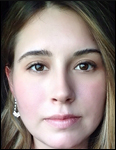|
 University of Kansas - Research Experience for Undergraduates - June 1 - July 24, 2105 University of Kansas - Research Experience for Undergraduates - June 1 - July 24, 2105 |
CReSIS Sponsored REU/RET Students
Introductory Flyer from KU can be found HERE >>>>
2015 KU Student Handbook >>>>>>
Professional Development Seminars >>>>>>
KU Summer UR Events >>>>>> |

Full Paper - Word/PDF |
Jennah Seaver
JR - Elem Ed - Haskell Indian Nations University
jennahseaver@yahoo.com

Title: Analyzing the Efficacy of the Addition of a Survival Unit into the Science Program “Ice, Ice, Baby” to promote environmental awareness on behalf of the Center for Remote Sensing of Ice Sheets.
Abstract: Ice, Ice, Baby is a science program developed by the education team of the Center for Remote Sensing of Ice Sheets (CReSIS). The inquiry-based, hands-on activities built into the program are designed to help students understand the dynamics of polar ice sheets in sea level rise on a basic level. Ice, Ice, Baby lessons not only give educators an opportunity to expand the environmental awareness of their students, but they serve as platforms for the teaching of scientific principles to fulfill the national and Kansas state standards. The “survival unit” of Ice, Ice, Baby is an effective component of the program because, rather than limiting lessons to the physical terrain, it instead focuses lessons on the people involved in it, a relatable topic which may stimulate interest and creativity among youth; potentially increasing productivity. Lessons involve why explorers must develop awareness of and solutions for hazards such as ice thickness, frigid temperatures, food scarcity, and lack of shelter. The lessons associated with these topics are designed to be inquiry-based, hands-on, and to meet the national and state standards for school districts.
|
| |
|

Full Paper - Word/PDF |
Laurissa Marcotte
JR - Aerospace Eng - University of Kansas
laurissa@ku.edu

Title: Characterizing the Effects of Carbon Fiber Composite Materials on the Performance of Remote Sensing Antennas
Abstract: Carbon fiber composite materials have many useful structural applications on modern aircraft. The Center for Remote Sensing of Ice Sheets (CReSIS) utilizes carbon fiber composite materials on various aircraft, which fly over ice sheets in Greenland and Antarctica to collect climatological data. The data is collected by radar systems on the aircraft. This study proposes to characterize the effects of carbon fiber composite materials on the performance of CReSIS's remote sensing antennas. |
| |
|

Full Paper - Word/PDF |
Abbey Whislers
JR - GEO INFO - University of Kansas
awhisler08@gmail.com

Title: A Graphical User Interface and Database Management System for Documenting Glacial Landmarks
Abstract: The purpose of this landmarks project is to enable users to mark glacial features they find in the echogram and save their coordinates and description to the database directly from the Data Picker, which is a custom graphical user interface created by CReSIS to allow users to explore CReSIS’ echogram images in an image browser window. At present, if users wished to record any landmarks observed in the echogram they would make a note in a shared spreadsheet. The landmark tool will be faster and more precise than this method because it saves the exact GPS time and two way travel time of the landmark to the database automatically.
The first part of this project is to update the Python/Django scripts into the CReSIS Open Polar Server so that they can store the landmark data users will input in a PostgreSQL table, and the second part of the project is to write the matlab code to construct a graphical user interface that can accept user input and call the Python/Django scripts. Guidance from my mentor, John Paden, along with some instruction from the CReSIS GitHub page and the Django and Matlab help pages will be my most important resources in this project.
|
| |
|

Full Paper - Word/PDF |
Austin Feathers
JR - ELEC ENG - University of Kansas
afeathers1@gmail.com

Title: Conformal Dual-Band HF Radar Antenna System Design for Implementation on a Small UAS
Abstract: High-frequency synthetic aperture radar (HF SAR) soundings from an aerial platform provide an effective method for sensing ice sheet basal topography. However, large manned aircraft are expensive to operate, and introduce risk to the crew, and pilot error in sounding measurements. Small unmanned aerial systems provide safe and inexpensive platforms for this radar equipment, necessitating the development of electrically small wide-band HF/VHF antenna systems that may be implemented conformally to the structure of the aircraft, as to avoid affecting the platform's aerodynamic properties. Metalization of the non-conductive aircraft surface was used to produce the antenna elements, which will be switched electrically for dual-band operation. |
| |
|
| |
|
|
